A Static Laser Weeding Device and System Based on Fiber Laser: Development, Experimentation, and Evaluation
Abstract
1. Introduction
2. Materials and Methods
2.1. The Device and System for Laser Weeding
2.1.1. Overview
2.1.2. Laser Weeding System
2.1.3. Laser Weeding Device
2.2. The Static Laser Weeding Experiment
2.2.1. Weed Plants
2.2.2. Laser Weed Cutting Experiment
2.2.3. Evaluation of Statistical Analysis
3. Results
3.1. Experimental Effect of Laser Irradiation Distances and Time
3.2. Analysis of Evaluation Factors Affecting Laser Weeding
4. Discussion
5. Conclusions and Outlook
Author Contributions
Funding
Data Availability Statement
Acknowledgments
Conflicts of Interest
References
- Westwood, J.H.; Charudattan, R.; Duke, S.O.; Fennimore, S.A.; Marrone, P.; Slaughter, D.C.; Swanton, C.; Zollinger, R. Weed Management in 2050: Perspectives on the Future of Weed Science. Weed Sci. 2018, 66, 275–285. [Google Scholar] [CrossRef]
- Abouziena, H.; Haggag, W. Métodos alternativos de controle não químicos de plantas daninhas: Uma revisão. Planta Daninha 2016, 34, 377–392. [Google Scholar] [CrossRef]
- Barratt, B.I.P.; Moran, V.C.; Bigler, F.; van Lenteren, J.C. The status of biological control and recommendations for improving uptake for the future. BioControl 2017, 63, 155–167. [Google Scholar] [CrossRef]
- Oerke, E.-C. Crop losses to pests. J. Agric. Sci. 2005, 144, 31–43. [Google Scholar] [CrossRef]
- Sartorato, I.; Zanin, G.; Baldoin, C.; DE Zanche, C. Observations on the potential of microwaves for weed control. Weed Res. 2006, 46, 1–9. [Google Scholar] [CrossRef]
- Wang, X.; Huang, J.; Zhao, D.; Guo, H.; Li, C.; Zhang, B. Kinematics and statics analysis of a novle 4-dof parallel mechanism for laser weeding robot. INMATEH Agric. Eng. 2016, 50, 29–38. [Google Scholar]
- Sahin, H. A Review on Parameters Affecting the Choice of Alternative (Non-Chemical) Weed Control Methods. Eur. J. Eng. Technol. Res. 2019, 4, 16–19. [Google Scholar] [CrossRef]
- Boutin, C.; Strandberg, B.; Carpenter, D.; Mathiassen, S.; Thomas, P. Herbicide impact on non-target plant reproduction: What are the toxicological and ecological implications? Environ. Pollut. 2014, 185, 295–306. [Google Scholar] [CrossRef]
- Peillex, C.; Pelletier, M. The impact and toxicity of glyphosate and glyphosate-based herbicides on health and immunity. J. Immunotoxicol. 2020, 17, 163–174. [Google Scholar] [CrossRef]
- Wang, M.; Leal-Naranjo, J.-A.; Ceccarelli, M.; Blackmore, S. A Novel Two-Degree-of-Freedom Gimbal for Dynamic Laser Weeding: Design, Analysis, and Experimentation. IEEE/ASME Trans. Mechatron. 2022, 27, 5016–5026. [Google Scholar] [CrossRef]
- Xiong, Y.; Ge, Y.; Liang, Y.; Blackmore, S. Development of a prototype robot and fast path-planning algorithm for static laser weeding. Comput. Electron. Agric. 2017, 142, 494–503. [Google Scholar] [CrossRef]
- Zhu, H.; Zhang, Y.; Mu, D.; Bai, L.; Zhuang, H.; Li, H. YOLOX-based blue laser weeding robot in corn field. Front. Plant Sci. 2022, 13, 1017803. [Google Scholar] [CrossRef]
- Nadimi, E.S.; Andersson, K.J.; Jørgensen, R.N.; Maagaard, J.; Mathiassen, S.; Christensen, S. Designing, modeling and controlling a novel autonomous laser weeding system. In Proceedings of the 7th World Congress on Computers in Agriculture Conference Proceedings, Reno, Nevada, 22–24 June 2009. [Google Scholar]
- Mwitta, C.; Rains, G.C.; Prostko, E. Evaluation of Diode Laser Treatments to Manage Weeds in Row Crops. Agronomy 2022, 12, 2681. [Google Scholar] [CrossRef]
- Heisel, T.; Schou, J.; Andreasen, C.; Christensen, S. Using laser to measure stem thickness and cut weed stems. Weed Res. 2002, 42, 242–248. [Google Scholar] [CrossRef]
- Wöltjen, C.; Haferkamp, H.; Rath, T.; Herzog, D. Plant growth depression by selective irradiation of the meristem with CO2 and diode lasers. Biosyst. Eng. 2008, 101, 316–324. [Google Scholar] [CrossRef]
- Rakhmatulin, I.; Andreasen, C. A Concept of a Compact and Inexpensive Device for Controlling Weeds with Laser Beams. Agronomy 2020, 10, 1616. [Google Scholar] [CrossRef]
- Schou, J.; Heisel, T.; Nordskov, A.; Christensen, S.; Jensen, P.S.; Thestrup, B.; Toftmann, B. Quantitative laser cutting of plants. In International Symposium on High-Power Laser Ablation; 2002; pp. 734–743. [Google Scholar] [CrossRef]
- Andreasen, C.; Hansen, L.; Streibig, J.C. The Effect of Ultraviolet Radiation on the Fresh Weight of Some Weeds and Crops. Weed Technol. 1999, 13, 554–560. [Google Scholar] [CrossRef]
- Couch, R.; Gangstad, E.O. Response of Waterhyacinth to Laser Radiation. Weed Sci. 1974, 22, 450–453. [Google Scholar] [CrossRef]
- Nadimi, M.; Sun, D.-W.; Paliwal, J. Recent applications of novel laser techniques for enhancing agricultural production. Laser Phys. 2021, 31, 053001. [Google Scholar] [CrossRef]
- Noble, S.D.; Brown, R.B.; Crowe, T.G. The use of spectral proplerties for weed detection and identification—A review. In Proceedings of the AIC 2002 Meeting CSAE/SCGR Program, Saskatoon, Saskatchewan, 14–17 July 2002. [Google Scholar]
- Pannacci, E.; Lattanzi, B.; Tei, F. Non-chemical weed management strategies in minor crops: A review. Crop Prot. 2017, 96, 44–58. [Google Scholar] [CrossRef]
- Shah, R.; Lee, W.S. An approach to a laser weeding system for elimination of in-row Weeds. In Precision Agriculture’15; Wageningen Academic: Wageningen, the Netherlands, 2015; pp. 307–312. [Google Scholar] [CrossRef]
- Andreasen, C.; Scholle, K.; Saberi, M. Laser Weeding With Small Autonomous Vehicles: Friends or Foes? Front. Agron. 2022, 4, 841086. [Google Scholar] [CrossRef]
- Li, J.-L.; Su, W.-H.; Zhang, H.-Y.; Peng, Y. A real-time smart sensing system for automatic localization and recognition of vegetable plants for weed control. Front. Plant Sci. 2023, 14, 1133969. [Google Scholar] [CrossRef] [PubMed]
- Osadčuks, V.; Kostromins, A.; Pecka, A.; Koteļeņecs, V.; Jaško, J. Experimental efficiency evaluation of 445 nm semicon-ductor laser for robotized weed control applications. Agron. Res. 2020, 18, 1380–1387. [Google Scholar]
- Arsa, D.M.S.; Ilyas, T.; Park, S.-H.; Won, O.; Kim, H. Eco-friendly weeding through precise detection of growing points via efficient multi-branch convolutional neural networks. Comput. Electron. Agric. 2023, 209, 107830. [Google Scholar] [CrossRef]
- Andreasen, C.; Vlassi, E.; Johannsen, K.S.; Jensen, S.M. Side-effects of laser weeding: Quantifying off-target risks to earthworms (Enchytraeids) and insects (Tenebrio molitor and Adalia bipunctata). Front. Agron. 2023, 5, 1198840. [Google Scholar] [CrossRef]
- Heisel, T.; Schou, J.; Christensen, S.; Andreasen, C. Cutting weeds with a CO2 laser. Weed Res. 2001, 41, 19–29. [Google Scholar] [CrossRef]
- Kaierle, S.; Marx, C.; Rath, T.; Hustedt, M. Find and Irradiate—Lasers Used for Weed Control. PhotonicsViews 2013, 10, 44–47. [Google Scholar] [CrossRef]
- Mathiassen, S.K.; Bak, T.; Christensen, S.; Kudsk, P. The Effect of Laser Treatment as a Weed Control Method. Biosyst. Eng. 2006, 95, 497–505. [Google Scholar] [CrossRef]
- Sorour, M.; From, P.J.; Elgeneidy, K.; Kanarachos, S.; Sallam, M. Compact Strawberry Harvesting Tube Employing Laser Cutter. In Proceedings of the 2022 IEEE/RSJ International Conference on Intelligent Robots and Systems (IROS), Kyoto, Japan, 23–27 October 2022; pp. 8956–8962. [Google Scholar]
- Shaner, D.L.; Beckie, H.J. The future for weed control and technology. Pest Manag. Sci. 2014, 70, 1329–1339. [Google Scholar] [CrossRef]
- Madić, M.; Radovanović, M.; Nedić, B.; Gostimirović, M. CO2 Laser Cutting Cost Estimation: Mathematical Model and Application. Int. J. Laser Sci. 2020, 1, 169–183. [Google Scholar]
- Morales-Orellana, R.J.; Winkelmann, T.; Bettin, A.; Rath, T. Stimulation of adventitious root formation by laser wounding in rose cuttings: A matter of energy and pattern. Front. Plant Sci. 2022, 13, 1009085. [Google Scholar] [CrossRef] [PubMed]
- Lan, Y.-P. Laser-optics-based method to suppress Mikania micrantha growth. Sci. Rep. 2022, 12, 19864. [Google Scholar] [CrossRef] [PubMed]
- Sorour, M.; From, P.J.; Elgeneidy, K.; Kanarachos, S.; Sallam, M. Produce Harvesting by Laser Stem-Cutting. In Proceedings of the 2022 IEEE 18th International Conference on Automation Science and Engineering (CASE), Mexico City, Mexico, 20–24 August 2022; pp. 487–492. [Google Scholar]
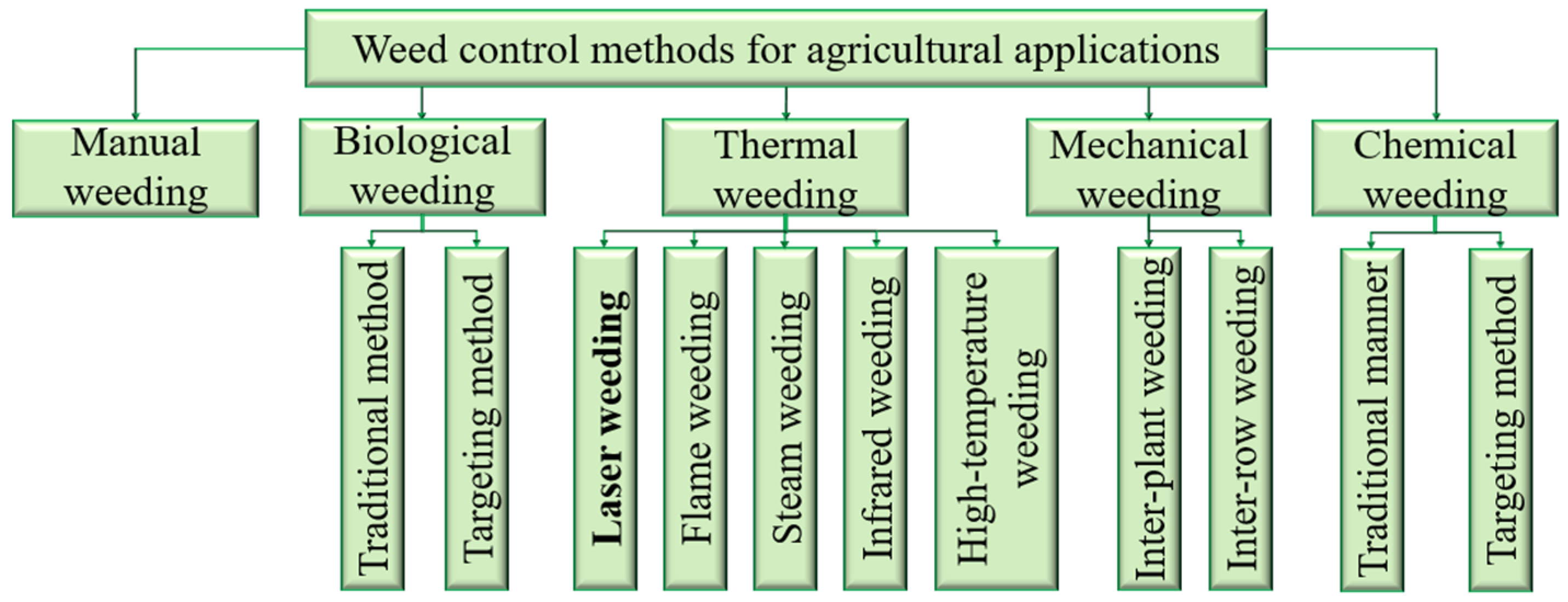
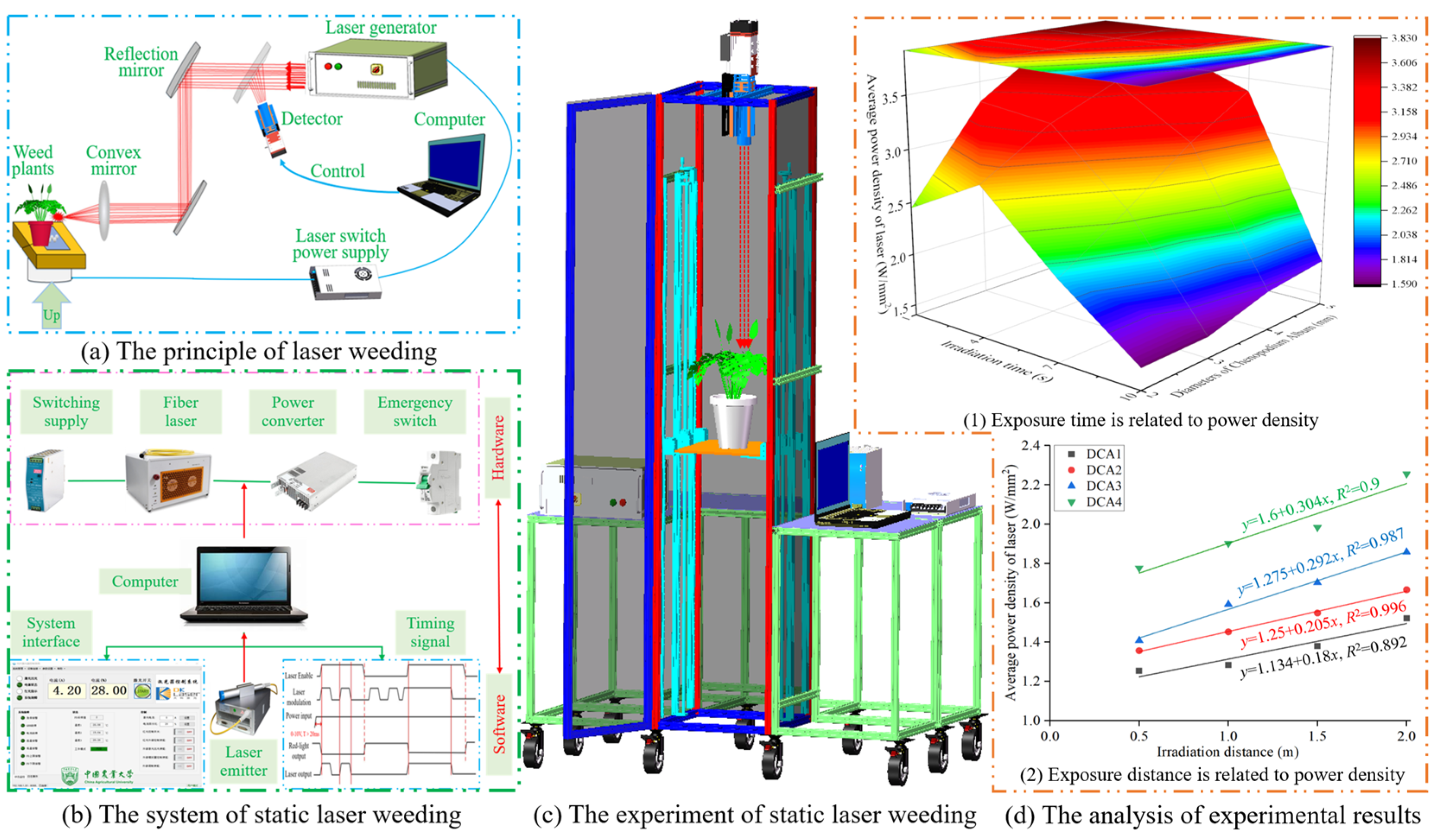
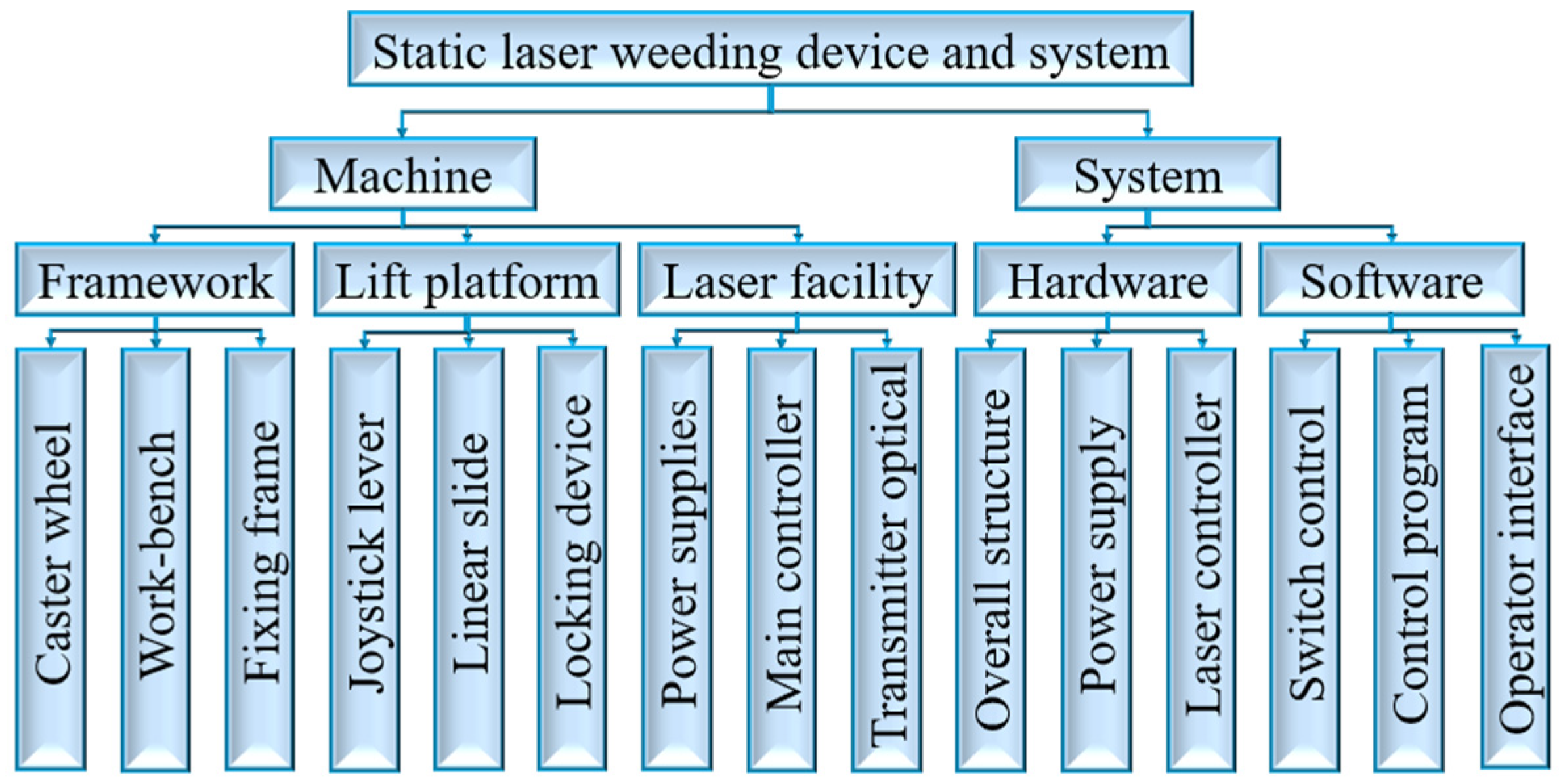
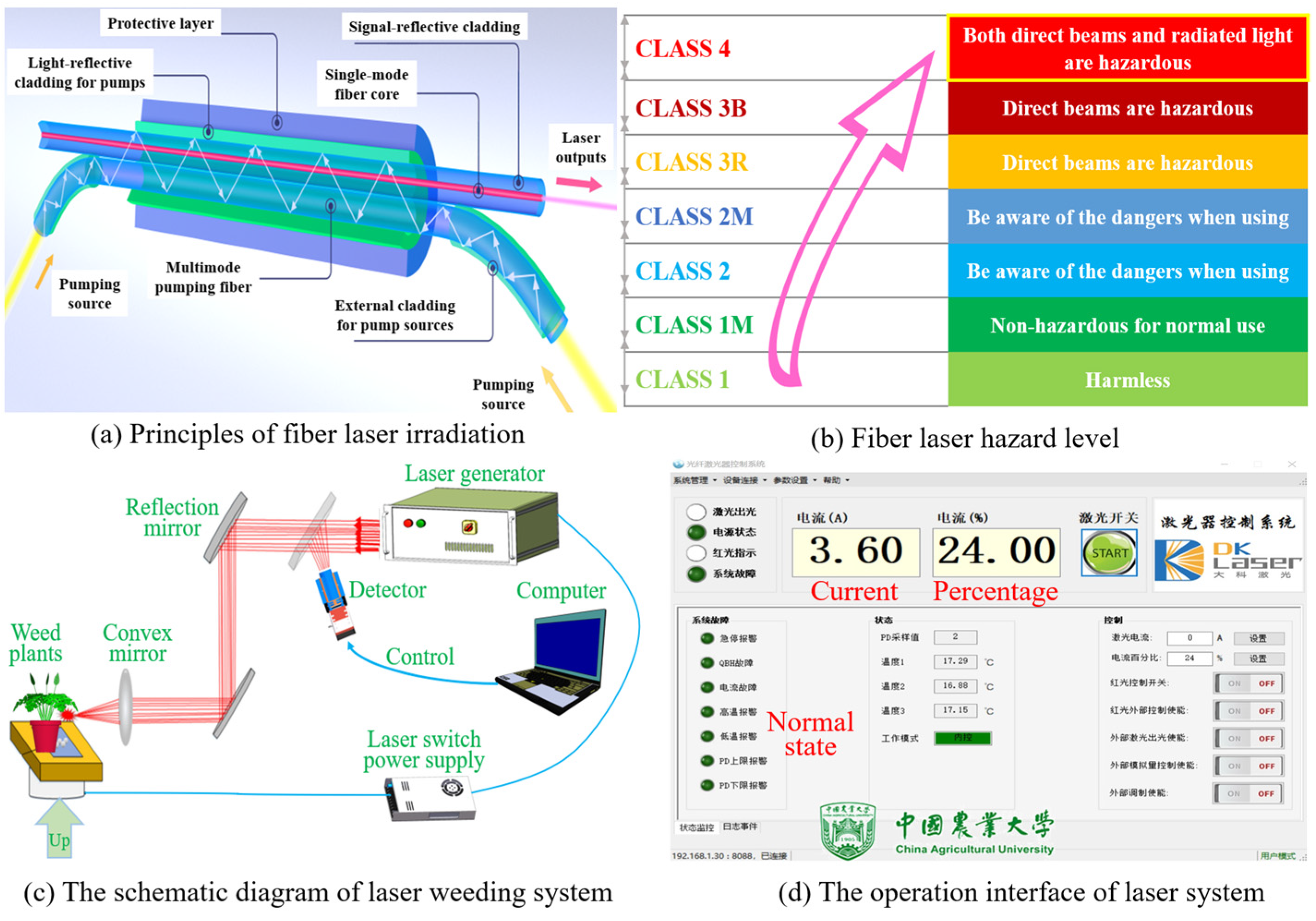
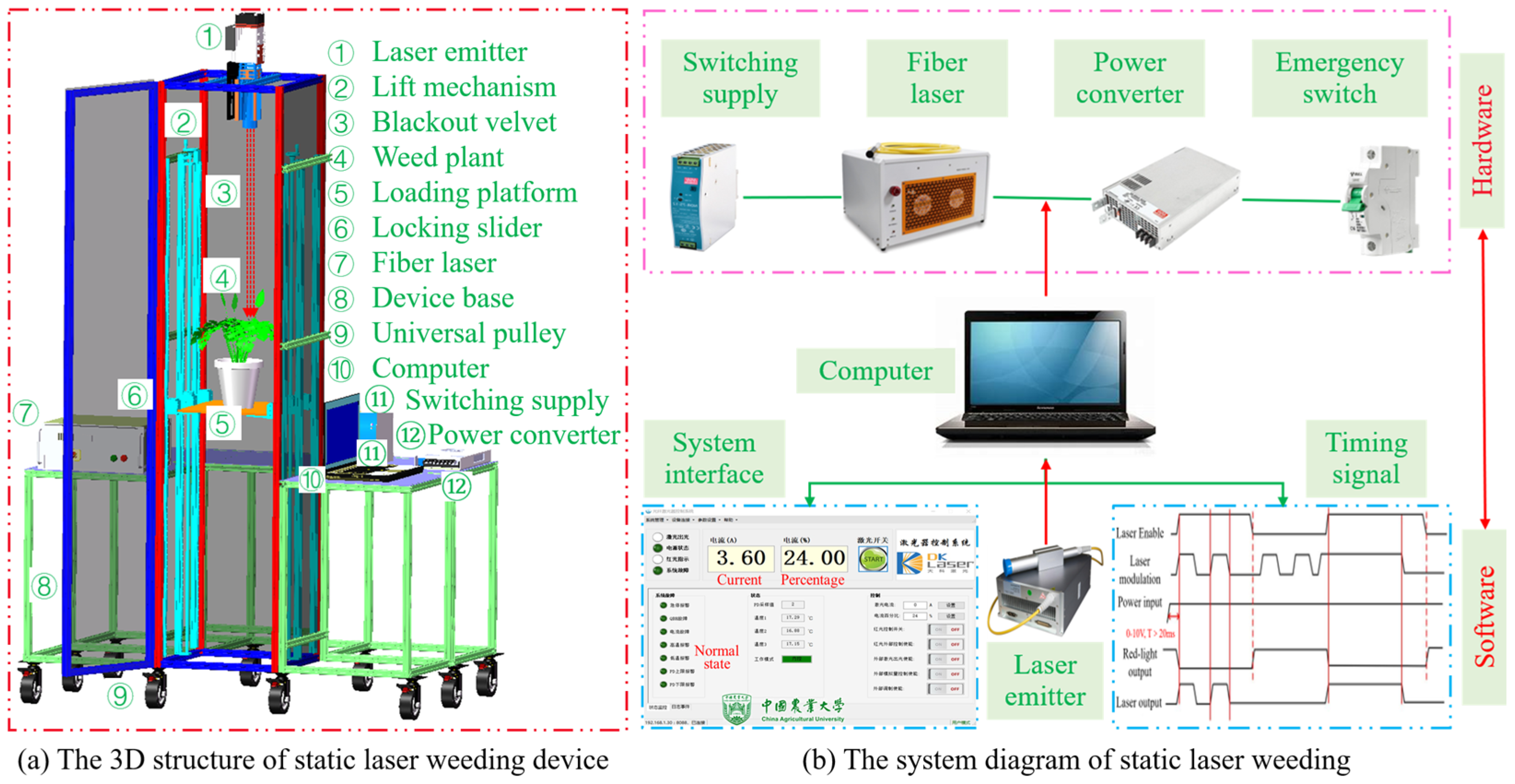
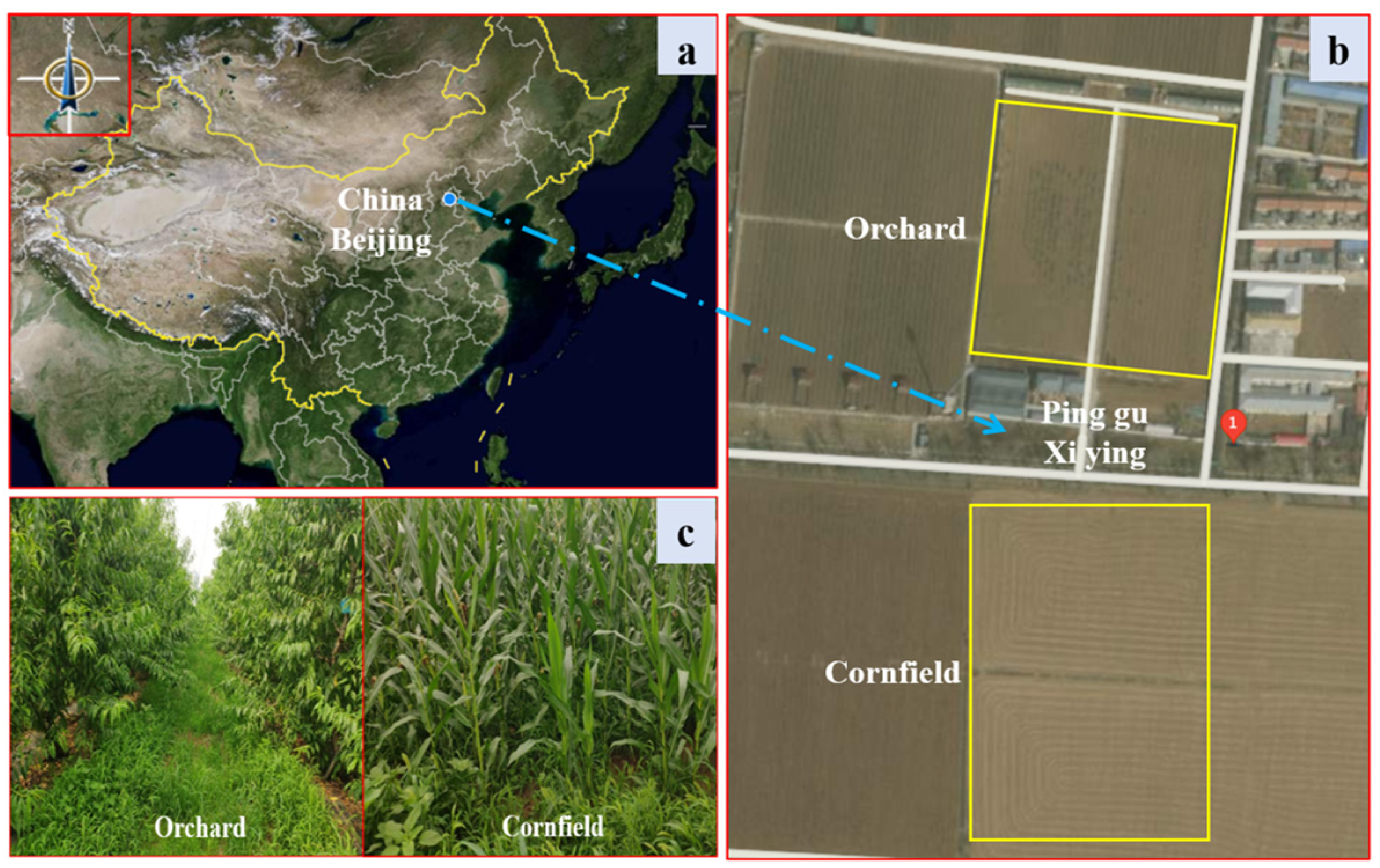
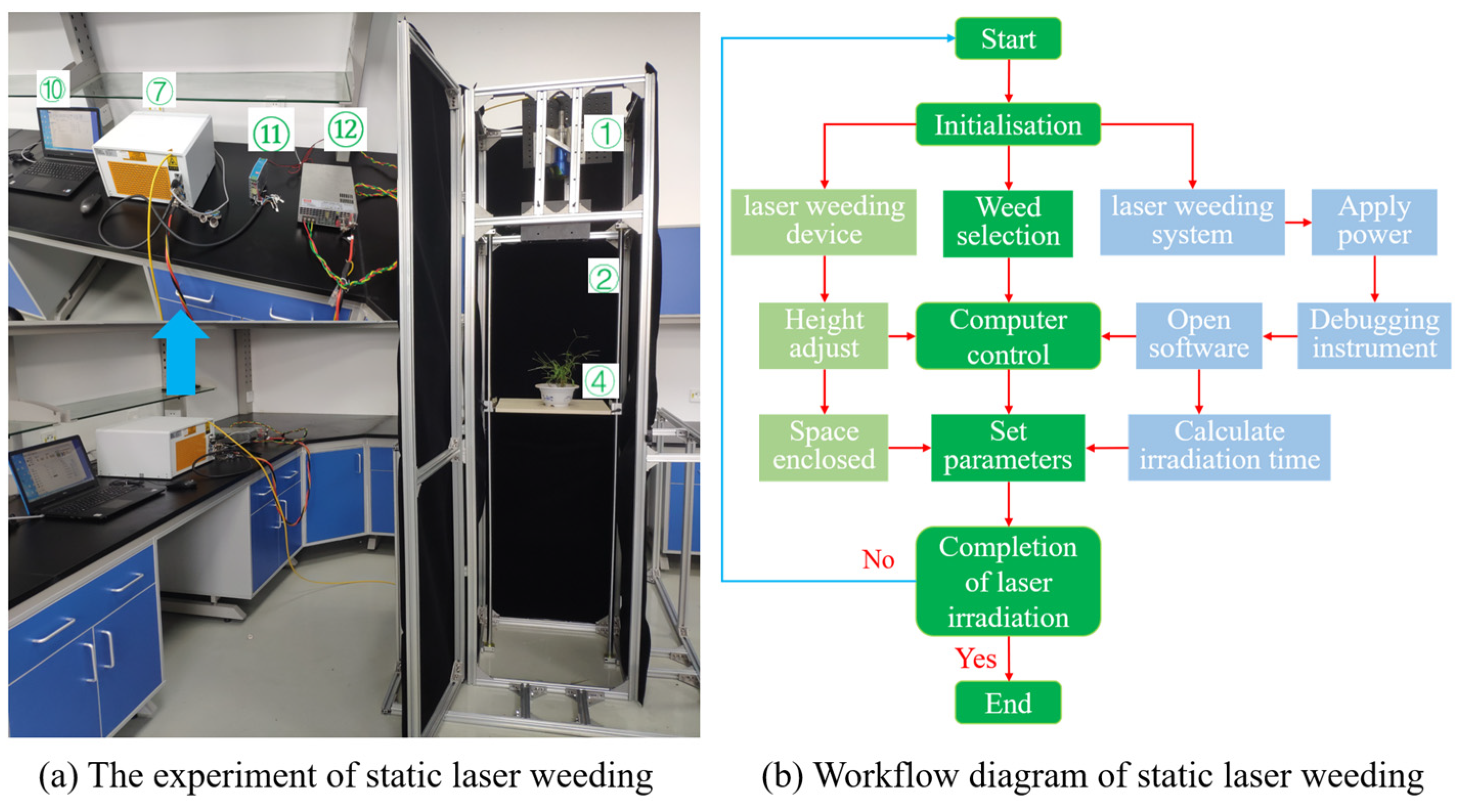
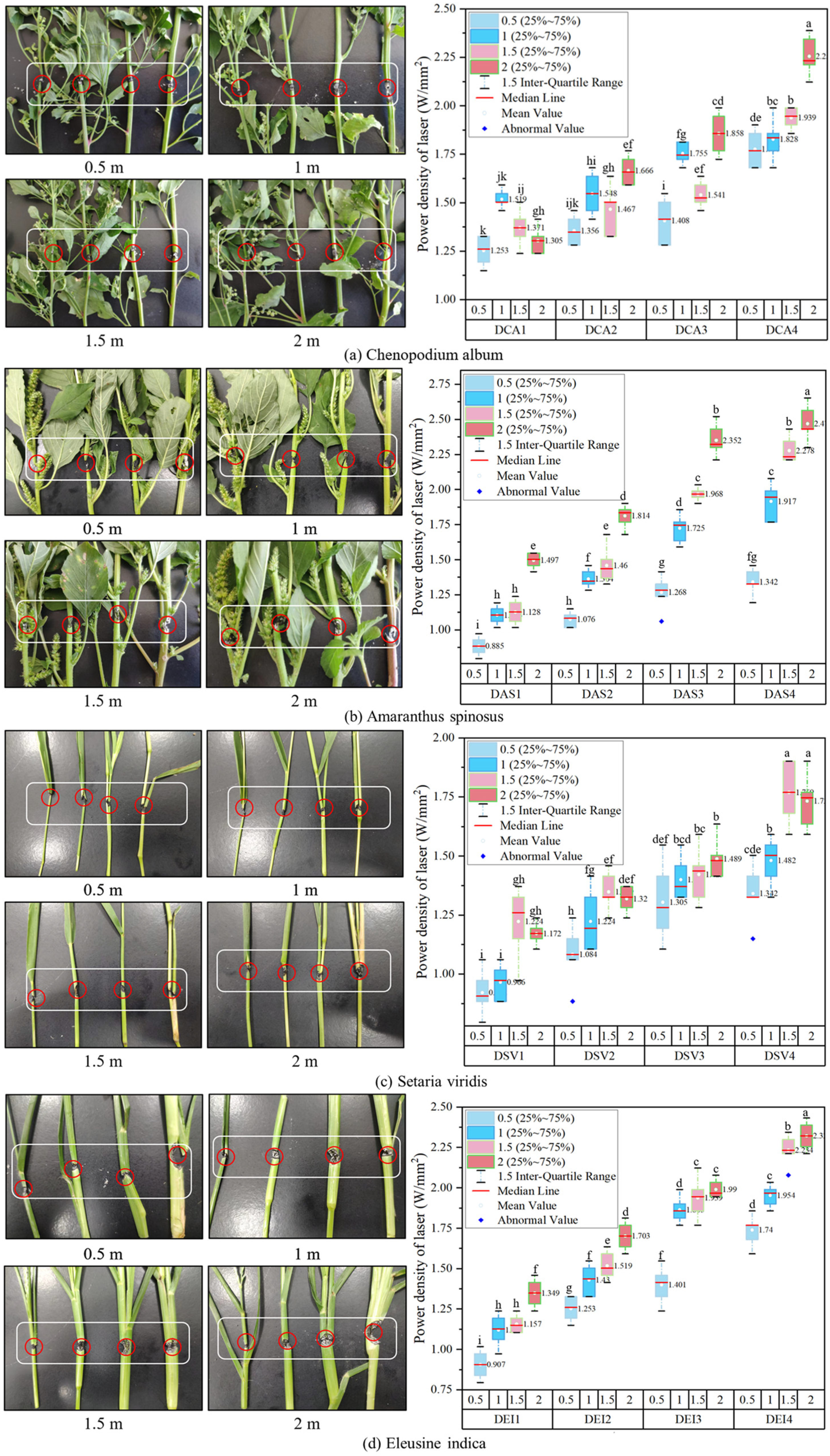
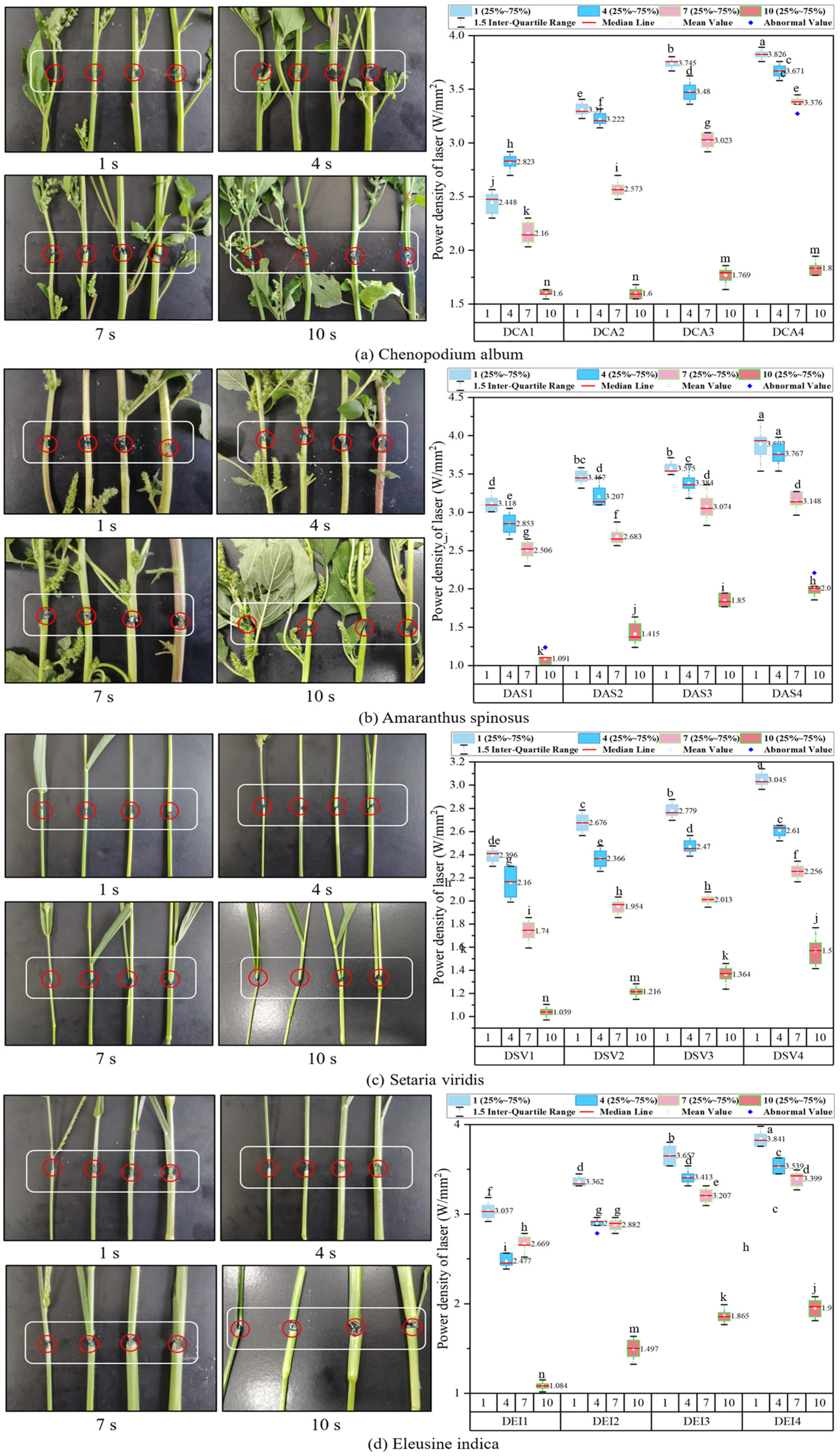

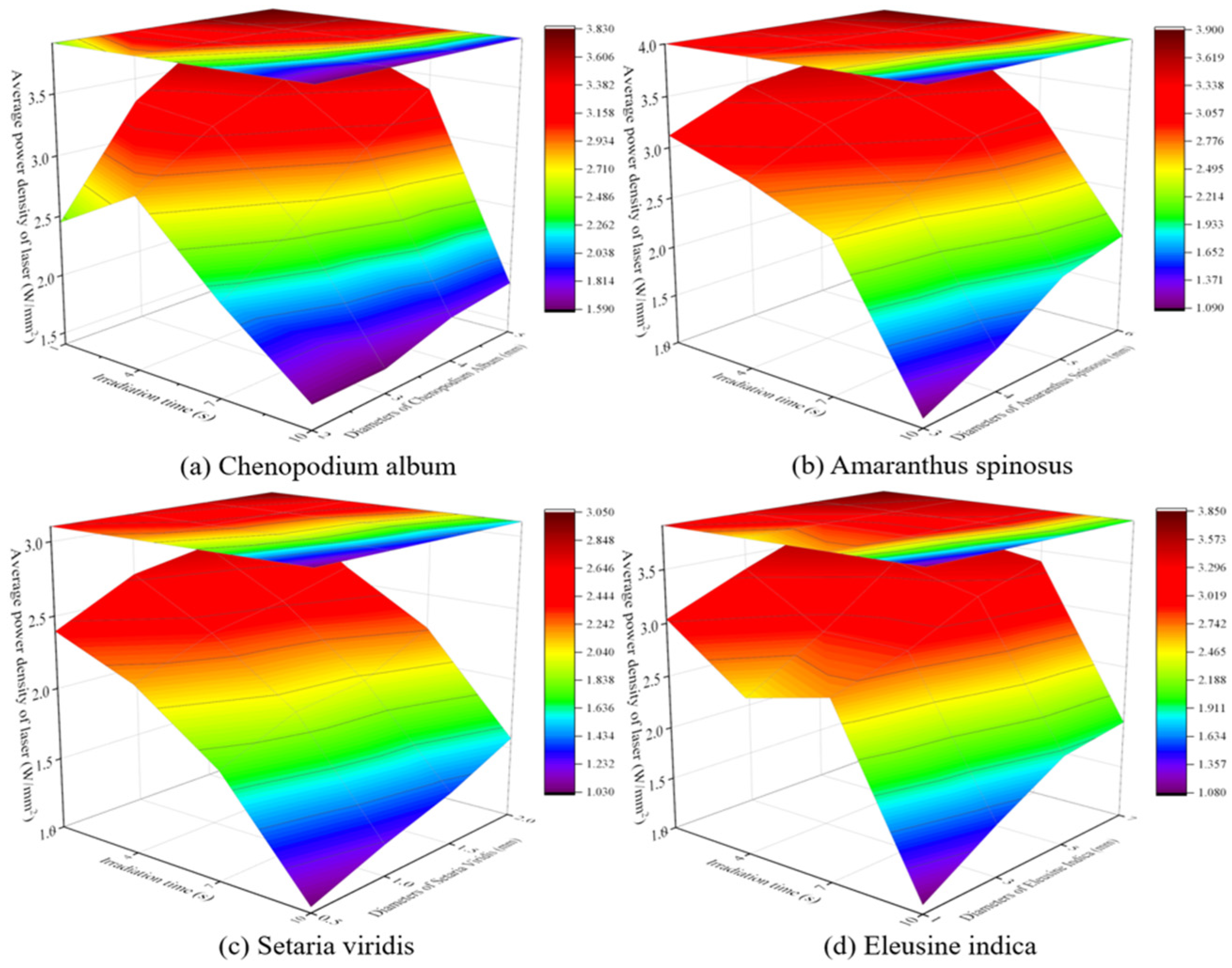
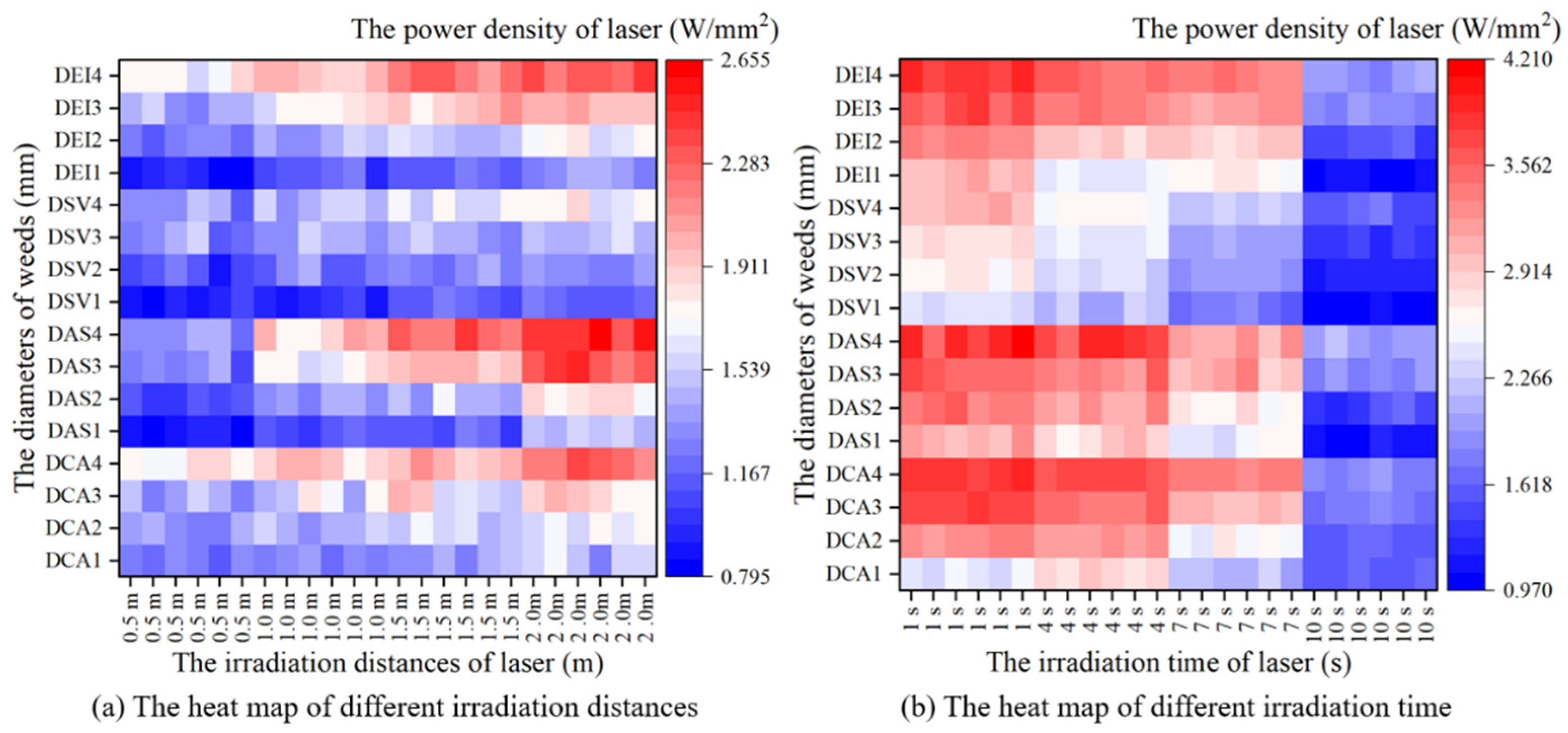
| Variables | Parameters | Variables | Parameters |
|---|---|---|---|
| Laser generator size (mm) | 380 × 310 × 230 | DC Voltage (V) | 45 |
| Fiber laser wavelength (nm) | 1080 ± 10 | NDR-75-12 (V) | 12 |
| Laser spot size (mm) | 12 | RSP-2400-24 (V) | 24 |
| Adjustable range of power (%) | 0~100 | External power (V) | 220 |
| Output fiber core diameter (μm) | 14 | Weight empty (kg) | 21 |
| Laser power consumption (kW) | 2 | Laser power (W) | 500 |
| Ambient temperature (°C) | 0~35 | Power range (W) | 50~500 |
| Weed Species | Chenopodium album | Amaranthus spinosus | Setaria viridis | Eleusine indica |
|---|---|---|---|---|
| Images of weed samples |  |  |  |  |
| Stem diameters (mm) | 2~5 | 3~6 | 0.5~2 | 1~7 |
| Growth height (cm) | 45~55 | 35~45 | 50~70 | 50~60 |
| The maximum width of the canopy (cm) | 10~20 | 10~20 | 5~10 | 5~15 |
| Number of weeds (plants) | 50 | 50 | 50 | 50 |
| Parameters | Variables | Abbreviation |
|---|---|---|
| The diameter of Chenopodium album (mm) | 2, 3, 4, 5 | DCA1, DCA2, DCA3, DCA4 |
| The diameter of Amaranthus spinosus (mm) | 3, 4, 5, 6 | DAS1, DAS2, DAS3, DAS4 |
| The diameter of Setaria viridis (mm) | 0.5, 1, 1.5, 2 | DSV1, DSV2, DSV3, DSV4 |
| The diameter of Eleusine indica (mm) | 1, 3, 5, 7 | DEI1, DEI2, DEI3, DEI4 |
| Laser irradiation distances (m) | 0.5, 1, 1.5, 2 | LID |
| Laser irradiation time (s) | 1, 4, 7, 10 | LIT |
| Replicates | 6 | / |
Disclaimer/Publisher’s Note: The statements, opinions and data contained in all publications are solely those of the individual author(s) and contributor(s) and not of MDPI and/or the editor(s). MDPI and/or the editor(s) disclaim responsibility for any injury to people or property resulting from any ideas, methods, instructions or products referred to in the content. |
© 2024 by the authors. Licensee MDPI, Basel, Switzerland. This article is an open access article distributed under the terms and conditions of the Creative Commons Attribution (CC BY) license (https://creativecommons.org/licenses/by/4.0/).
Share and Cite
Yu, Z.; He, X.; Qi, P.; Wang, Z.; Liu, L.; Han, L.; Huang, Z.; Wang, C. A Static Laser Weeding Device and System Based on Fiber Laser: Development, Experimentation, and Evaluation. Agronomy 2024, 14, 1426. https://doi.org/10.3390/agronomy14071426
Yu Z, He X, Qi P, Wang Z, Liu L, Han L, Huang Z, Wang C. A Static Laser Weeding Device and System Based on Fiber Laser: Development, Experimentation, and Evaluation. Agronomy. 2024; 14(7):1426. https://doi.org/10.3390/agronomy14071426
Chicago/Turabian StyleYu, Zhongyi, Xiongkui He, Peng Qi, Zhichong Wang, Limin Liu, Leng Han, Zhan Huang, and Changling Wang. 2024. "A Static Laser Weeding Device and System Based on Fiber Laser: Development, Experimentation, and Evaluation" Agronomy 14, no. 7: 1426. https://doi.org/10.3390/agronomy14071426
APA StyleYu, Z., He, X., Qi, P., Wang, Z., Liu, L., Han, L., Huang, Z., & Wang, C. (2024). A Static Laser Weeding Device and System Based on Fiber Laser: Development, Experimentation, and Evaluation. Agronomy, 14(7), 1426. https://doi.org/10.3390/agronomy14071426










